I’m excited to share what Chess Media Group has been working on. We call it our Adaptive Social Business Strategy (or framework). As I’ve mentioned in the past, Chess doesn’t believe in implementing a standard step-by-step process or methodology that is be applied to every organization. The trouble with many social business models today is that they don’t allow room for adaptation and manipulation; they put organizations into a box and expect them to move in a linear way to get to their goal, not being able to move forward until each preceding step is completed. This is not pragmatic or realistic, which is why we created something adaptive. Every organization has different needs in different areas which are not addressed. This strategy framework came from interviewing clients and organizations, case study research, and our own observations.
I welcome you feedback on our Adaptive Social Business Strategy and expect this to go through several adaptations based on feedback before we come up with a final model which can be used by all.
How to look at this:
At Chess Media Group we recognize that some organizations might have a rock solid organizational culture, a solid process, and a great technology stack but might be weak in the goals & objectives and governance areas. This framework is designed to let organizations look at and understand the key components that make up each sphere. Your organization might be great at one of the five areas, whereas another organization might be solid at three of the five. Organizations can maneuver through this framework to improve on areas where they are weak or perhaps not as strong as they would like to be. It’s adaptive because it doesn’t force organizations down a single path yet addresses the key areas for social business. Every organization can decide on which areas need to be worked on and which ones are solid. In the near future this will be followed up by a maturity model to help guide organizations further. The full image below is a bit too small to read all the details so I include each individual sphere as well.
We realize this is a first step and we are working on a few other things around this but we wanted to release our ideas as we are working on them to be able to incorporate any feedback from the community.
Please let me know what you think! What works what doesn’t? Is there anything missing?
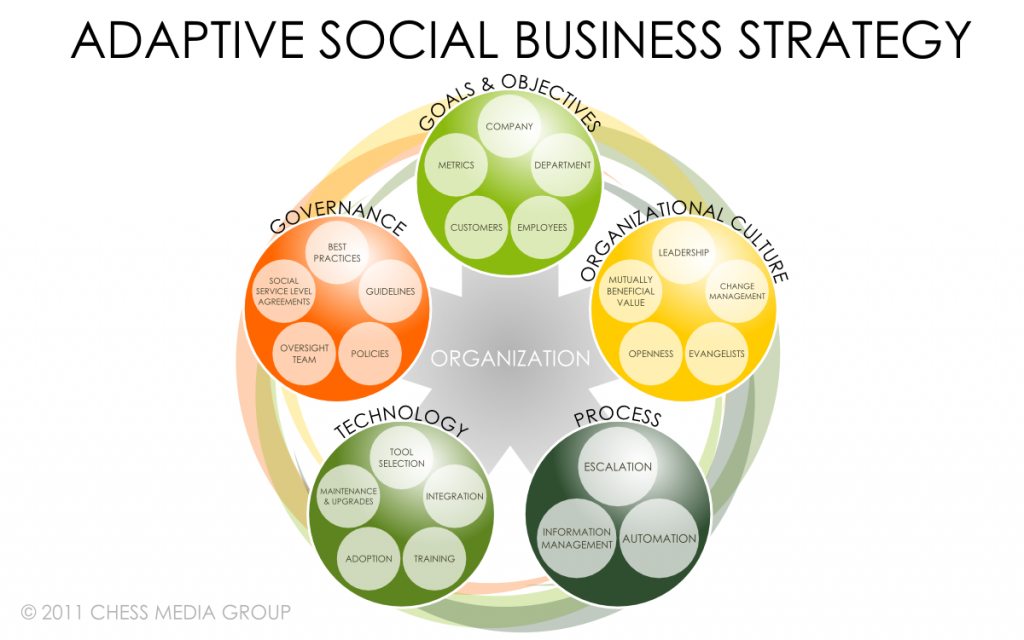
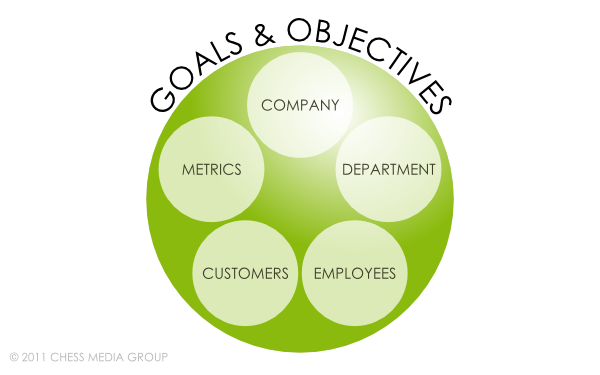
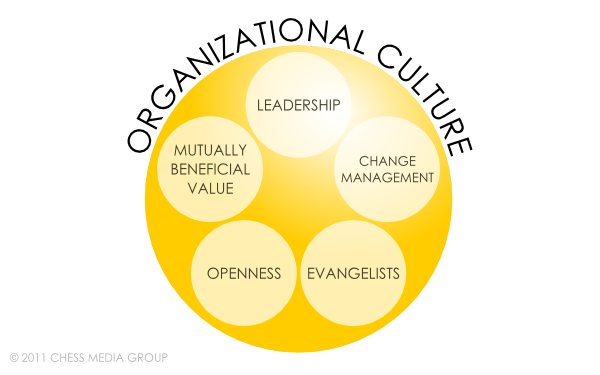
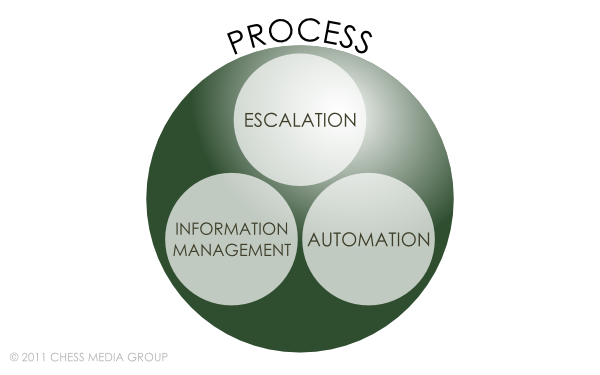
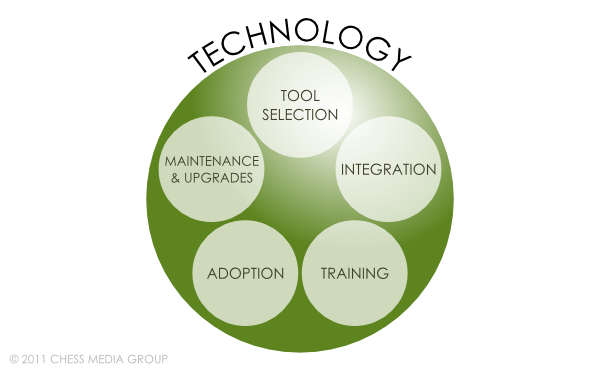
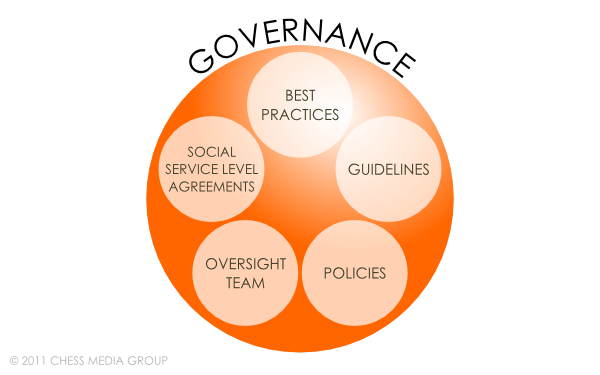
How we can help
- Conduct an assessment for your organization based on our maturity model
- Half day/full day training or strategy session on social business
- Strategy development and advisory relationship
- Assist with selecting the best enterprise collaboration solution(s)

Hi Jacob,
This is an interesting blog post, but I keep wondering how your framework is social? Somehow I fail to notice any elements in this particular framework that involves stakeholders outside the enterprise, and likewise do I fail to see how the framework adds value to individuals that might be socially exposed.
Can you enlighten me?
I hope you will be able to answer my question(s).
Best wishes,
Peter Flemming Teunissen Sjoelin
CoherencyArchitect.com
Very fair question. However, I’m not sure what you mean by making a framework “social.” I think the whole notion and the term “social” is throwing people off. Business is business regardless how you look at it. This framework was put together for organizations that are looking to solve business problems using social and collaborative tools. What this looks at are elements that allow these tools and strategies to be adopted successfully. Now originally when putting this together I was thinking it was more relevant to the enterprise collaboration space but I think it’s just as relevant to the customer facing side as well. As far as outside stakeholders go we do include: evangelists, customers.
Basically we looked at and interviewed organizations that were implementing or trying to go “social” and developed these common elements or themes within organizations. Not every sphere applies to every organization but then again this is going to be the basis for a maturity model which will allow organizations to see where they are strong and where they are week. Hopefully that makes more sense?
Hi Jacob,
It makes more sense; however what you have come up with seems pretty similar to what other frameworks within the sphere of Systems Thinking deals with (e.g., the Viable Systems Model), and in such case I don’t understand the choice of title for the blog post and the framework (or strategy or whatever).
My intention with my question was to uncover if the framework really added anything unique (besides six illustrations).
Thereto I find the focus on processes and technology slightly unconnected in the proposed framework e.g., how do you intend to obliterate the current processes or activities, and overwrite them with new processes that isn’t based on best practice workflows?
I can see there is a step named “change management” but I fail to see how the framework deals with the incentives that would be needed to make people adapt and adopt the new “lines of business” or “work processes”. Thereto why is a matrix needed to implement your framework? It seems like someone have been a bit too found of reading Kaplan and Norton while they produced the theoretical synthesis for the framework.
Likewise am I not sure on how the first illustration really differs from the theoretical concept that Leavitt proposed back in ’65.
Nonetheless I will wish you good luck with your future work with the framework and you can feel free to contact me if you need further clarification.
Best wishes,
Peter Flemming Teunissen Sjoelin
CoherencyArchitect.com
Much needed !…was looking forward to it ! Thanks Jacob for the Post !
Hi Jacob,
Great post and I really like the ideas behind your framework. You’re absolutely right, business don’t move strictly along a set path; there’s lots of tangents, off-shoots and backtracks. But I think there is something reassuring about the idea of accumulating knowledge or building upon and extending knowledge that is sometimes best expressed in a linear fashion.
I liked your response to a comment about business is business even when talking about social. It’s the integration of social analytics, technologies and tools into existing or new business intelligence that provides the real opportunity for business growth.
Thanks again!
@collectual
Hi Jacob,
This framework is really good. It captures all aspects of the business strategy. Where it gets tricky is when you go down couple of layers into a detailed level that many organization pose challenges in one or more of these spheres. Identifying the challenges is easier but the how to fix gets tougher for most medium sized and large organization due to the inherent size and complexity of the organization.
But definitely, I like the approach of doing away with the linear thinking. This is a good framework to begin an engagement.
Thanks
RG
agree with you. plus i liked a lot that presenation. pictures look vey simple and help a lot in aunderstanding the general scheme… thanks a lot to the author!
Peter, I think the most significant item you pointed out, lack of stakeholder involvement, is important. A cross functional group should include customers/ partners/ employees.
Wendy Soucie
xeesm.com/wendysoucie
I agree with Peter’s comment — the framework is not social — it’s far more typical to most other business initiatives. In my opinion, this is what makes it so relevant and important. Moreover, this finding is consistent with what other thought leaders in this space have found to be true (I’m thinking of one of the recent Altimeter reports). Whereas “social” is the topic, the process of business is still business. You still have to pay attention to goals and measurements and processes etc. Real companies still operate as real companies — and trans-formative initiatives like “social” remind me of prior initiatives like “Quality” (in the late 80s), “ERP” in the early 90s, and “e-business” in the late 90s.
I think it’s very healthy to view a social initiative as a business initiative, and not imagine that employees will self-organize the way consumers do around cool ideas. Employees still operate in a mechanism that operates with governance (we have managers and corporate goals) and marketplaces (we get salaries and bonuses) — so our behaviors are impacted and changed via the mechanisms of business transformation.
Yes, Social is different — it is by definition more inclusive, egalitarian, and flatening to an organization. But I was very impressed with this framework because it makes sense to the way I think business think about initiative. just my opinion :-).
thanks for the kind words!
Thanks for the comment. It’s definitely a starting point but I’m hoping it will evolve from here!
Thanks for the comment, I completely agree with you. Getting down deeper into the layers is definitely a tricky part which is why I feel it is better left for organizations to figure out how those layers fit within their organizations. I like to provide the high level framework and let organizations work from there…unless of course they are a client of ours 🙂
Thanks for the kind words!
Interesting post and thanks for sharing. Some things in here I have not thought about before.Thanks for making such a cool post which is really very well written.will be referring a lot of friends about this.Keep blogging
really interesting, something to think about
thanks for this, great graphics as well
some great ideas there, cool
It is a good idea to build a sound knowledge of fundamental analysis
early on. It’s also arguably easier to pick up than technical analysis, so it’s
best to start with fundamentals. Look into technical analysis. This type of
analysis might seem a little daunting to beginners, as it is all about price
charts and graphs, candlestick patterns, technical indicators etc.
it was lovely reading you this blog. Dissertation Writing Service
Reading baout business strategies helps people to run their business successfully. Dissertation Writing Service
Awesome post by thefutureorganization.com! The area of adaptive social business strategy frame is very interesting and thought-provoking.
I really like this post by thefutureorganization.com! The topic of adaptive social business strategy frame is incredible interesting and I’m glad I stumbled upon this post.